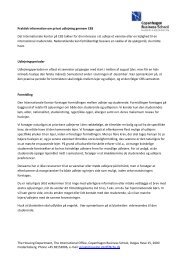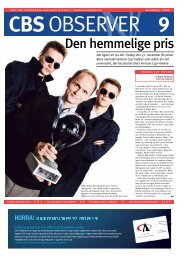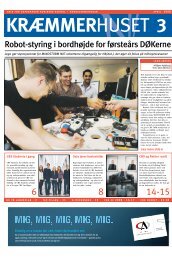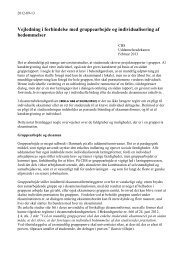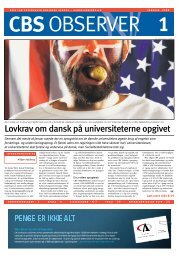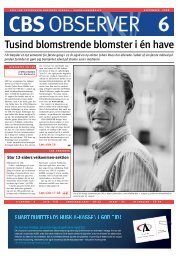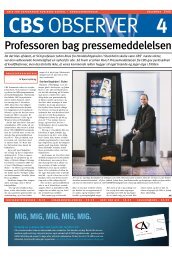Untitled - CBS Observer
Untitled - CBS Observer
Untitled - CBS Observer
You also want an ePaper? Increase the reach of your titles
YUMPU automatically turns print PDFs into web optimized ePapers that Google loves.
In the chocolate value chain, processing has become a scale<br />
business with relatively low margins. Globally, the processing<br />
phase is therefore concentrated with a very small group<br />
of companies that rely on economies of scale for their competitive<br />
advantage. Industrial chocolate producers generally<br />
belong in one of two categories: integrated producers or industrial<br />
processors. Integrated producers process the industrial<br />
chocolate mainly for their own consumer chocolate.<br />
This group mainly encompasses the largest branded chocolate<br />
manufacturers in the world – those that have the volume<br />
to build large processing facilities. The second group,<br />
the industrial processors, primarily supplies its production<br />
of industrial chocolate to third parties. This group is dominated<br />
by three companies: Barry Callebaut (BE), Acher Daniels<br />
Midland (US), and Cargill (US). These three companies<br />
alone control approximately two thirds of the global cocoa<br />
processing market.<br />
Toms’ in-house processing facility makes it a member of the<br />
first group. However, in-house processing is highly uncommon<br />
among confectionery companies of Toms’ size. In fact,<br />
Toms is one of very few European chocolate manufacturers<br />
that have moved the processing phase in-house. For Toms,<br />
chocolate processing control can be compared to the work of<br />
a chef. To influence the taste of the end product, a chef must<br />
16<br />
<strong>CBS</strong> CASE COMPETITION 2013<br />
start from scratch with the ingredients. By having control of<br />
the processing, Toms can not only cater specifically to the<br />
tastes of its customers, but also have significantly greater control<br />
of the cocoa origin.<br />
In-house processing, however, comes at a price. There are<br />
large fixed costs involved in owning the processing machinery.<br />
It is therefore imperative for the processing facility to maintain<br />
the throughput volume to keep the machinery in operation.<br />
For this reason, the majority of chocolate manufacturers today<br />
have outsourced cocoa processing altogether. Most chocolate<br />
manufacturers, ranging from mass-market producers to highend<br />
chocolate artisans, buy the majority of their input from<br />
large integrated cocoa processors in the form of industrial<br />
chocolate. They instead differentiate themselves in the next<br />
stage of the chocolate supply chain: manufacturing.<br />
Manufacturing<br />
In the final stage of chocolate production, industrial chocolate<br />
is transformed into the unique chocolate products with<br />
which consumers are familiar. Before it is packaged, industrial<br />
chocolate is combined with other ingredients, tempered<br />
and molded.<br />
The keys to chocolate manufacturing are efficiency and flexibility.<br />
Efficiency is more easily attained for the industry’s<br />
largest players that can gather the volumes to build automated<br />
production facilities around just one brand. Toms cannot.<br />
Instead, Toms must produce its product series in batches,<br />
before reconfiguring its machines to produce the next series.<br />
Reconfiguring a machine means manual labor and, more<br />
importantly, considerable downtime. Reconfiguring is therefore<br />
costly.<br />
Of Toms’ five manufacturing facilities, chocolate is only produced<br />
in two locations: the factory by the headquarters in<br />
Ballerup, Denmark, and the Hanseatische factory in Bremen,<br />
Germany. Toms’ product assortment covers approximately<br />
1,000 different raw material inputs and 1,000 different packaging<br />
designs. Each product requires a unique combination<br />
of ingredients. Several retailers also require unique packaging,<br />
which adds significant complexity to the mix. Moreover,<br />
Toms has approximately 250 product changes every year.<br />
Although the majority of these changes are very small, the<br />
sheer number of changes speaks to the complexity and pace<br />
of the market. Flexibility in production and work shifts allows<br />
Toms to quickly respond to new trends and demands from<br />
customers. Cost control, however, is still imperative. In an<br />
effort to reduce cost, Toms offshored parts of its labor-inten-<br />
sive manufacturing to Poland in the spring of 2012. The Polish<br />
facility is responsible for non-automated packaging. This<br />
means that chocolate and sugar Confectionery products are<br />
manufactured in Denmark and subsequently shipped to Poland<br />
for packaging, before they are shipped back to Denmark<br />
for redistribution.<br />
In summary, chocolate manufacturing is a balancing act.<br />
From a production efficiency perspective, Toms must drive<br />
down cost by gathering critical mass to achieve higher volumes<br />
per batch. This includes streamlining its product portfolio<br />
to minimize the number of machine reconfigurations.<br />
From a marketing perspective, however, Toms faces pressure<br />
from demand for new packaging, new product launches and<br />
delivery flexibility.<br />
Origin Processing Manufacturing Sales<br />
17




